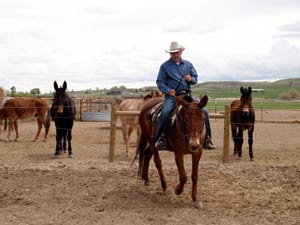 |
| TIM rides Angel
in a small circle next to her pasture buddies |
Have you ever had a
mule that refused to leave other mules? Maybe you own more than
one mule. Does your mule get nervous or excited when riding
alone? Does he ignore your cues when his buddy is out of sight?
This can be a very frustrating and dangerous problem. But the
good news is you can fix the problem and have a well mannered
mule whether you are riding with a group or alone.
First, you must understand that mules are herd animals. They are
used to living and being around other mules or horses. When in a
herd setting, the mule relies on other animals in the herd to
keep him safe. In the wild, it is much easier for a herd of
animals to detect predators, than a single animal. This gives
the individual animals of the herd a sense of security and
comfort.
So, just as your mule would with his herd, always start your
training where you and your mule are safe and comfortable. This
may mean starting your training in an arena, or from the ground.
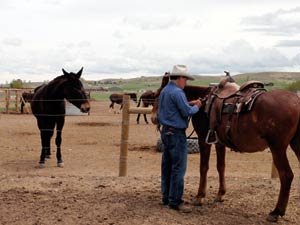 |
| Start with your
mule next to his buddy |
If your mule is unsafe to ride when he or she is “buddy sour” or
will not respond to your basic cues away from his buddy, start
your training from the ground. We will teach you how to solve
the problem as if you are riding your mule, but if you are
starting from the ground, the lesson will be the same.
You will need a friend and your mule’s “buddy.” Have a friend
ride the mule’s buddy. Ride side by side for a couple of
minutes. When both mules are calm and relaxed, turn your mule,
the buddy sour mule, in a small 10 meter or 20 meter circle away
from his buddy. What you are doing is separating the mules for a
split second.
The buddy sour mule will think that his buddy is gone when you
turn him away in a circle. But, before he gets excited, he will
be back next to his buddy. You are teaching your mule that there
is nothing to get excited about, but in small increments.
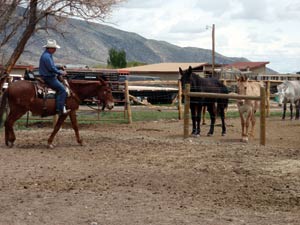
TIM calmly rides circles. |
A few minutes later, repeat your circle again. Remember you are
making a small easy circle, separating the mules for one or two
seconds. Do not spin the mule in a tight circle or ride a large
circle. Keep the mule calm and relaxed by doing 10 meter or 20
meter circles, ensuring he will be back to his buddy in a few
seconds. If the mule gets excited from the separation, you are
making too large of a circle.
Once the mule is calm
and responsive to your cues, when you make a small circle away
from his buddy, increase the size of the circle. You want to
slowly increase the amount of time the mule is separated from
his buddy. Make sure the mule is always calm and relaxed before
you increase the time of separation.
If the mule does not respond to your cues, decrease the size of
your circle until the mule responds; your mule is telling you
that you are going too fast. Slowly build the time and distance
you separate the mules.
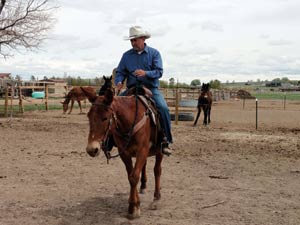 |
| Once the mule
is calm and responsive to your cues, when you make a
small circle away from his buddy, increase the size
of the circle. |
Some examples would be to ride out on the trail or pasture
instead of the arena. Trot the mules instead of walking. Always
remember to ride
where you can, not where you can’t.
If you feel unsafe
and your mule does not respond to your cues out on the trail or
at the trot, then ride in an arena or walk. Build a positive
experience for you and your mule. Remember you are teaching your
mule that there is nothing to be afraid of. So, do not place
your mule in a situation where he is unresponsive. You want your
mule to raise his level of fear, but only a little so you can
control it and have him respond safely. Over time you can
increase the fear level and because of your repetition, you will
get a safe response.
A good trainer is constantly evaluating the current situation,
the lesson being taught, and the mule being trained. What if you
do not have a friend to help you? You must think of safe options
to
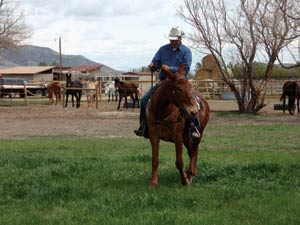 |
| Over time you
can increase the fear level and because of your
repetition, you will get a safe response. |
teach the lesson to
the mule.
Ride the mule next to the pasture or pen where his buddy is.
Make sure the pasture or pen is not so large that your mule’s
buddy can get far
away from the mule you are riding
If your mule’s buddy is trained to stand calmly when tied, tie
your mule’s buddy in the arena you are riding in. Teach the
lesson the same way. The other mule will be in a small area as
not to get too far from the mule you are riding.
With this lesson, you can teach your mule that riding out alone
can be a safe, calm and good experience. Your mule will soon
understand that his or her buddy will always be waiting when you
return.
|